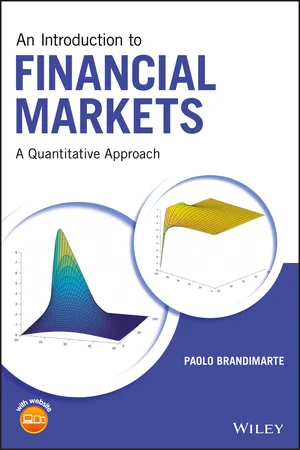
- English
- ePUB (mobile friendly)
- Available on iOS & Android
About this book
COVERS THE FUNDAMENTAL TOPICS IN MATHEMATICS, STATISTICS, AND FINANCIAL MANAGEMENT THAT ARE REQUIRED FOR A THOROUGH STUDY OF FINANCIAL MARKETS
This comprehensive yet accessible book introduces students to financial markets and delves into more advanced material at a steady pace while providing motivating examples, poignant remarks, counterexamples, ideological clashes, and intuitive traps throughout. Tempered by real-life cases and actual market structures, An Introduction to Financial Markets: A Quantitative Approach accentuates theory through quantitative modeling whenever and wherever necessary. It focuses on the lessons learned from timely subject matter such as the impact of the recent subprime mortgage storm, the collapse of LTCM, and the harsh criticism on risk management and innovative finance. The book also provides the necessary foundations in stochastic calculus and optimization, alongside financial modeling concepts that are illustrated with relevant and hands-on examples.
An Introduction to Financial Markets: A Quantitative Approach starts with a complete overview of the subject matter. It then moves on to sections covering fixed income assets, equity portfolios, derivatives, and advanced optimization models. This book's balanced and broad view of the state-of-the-art in financial decision-making helps provide readers with all the background and modeling tools needed to make "honest money" and, in the process, to become a sound professional.
- Stresses that gut feelings are not always sufficient and that "critical thinking" and real world applications are appropriate when dealing with complex social systems involving multiple players with conflicting incentives
- Features a related website that contains a solution manual for end-of-chapter problems
- Written in a modular style for tailored classroom use
- Bridges a gap for business and engineering students who are familiar with the problems involved, but are less familiar with the methodologies needed to make smart decisions
An Introduction to Financial Markets: A Quantitative Approach offers a balance between the need to illustrate mathematics in action and the need to understand the real life context. It is an ideal text for a first course in financial markets or investments for business, economic, statistics, engineering, decision science, and management science students.
Frequently asked questions
- Essential is ideal for learners and professionals who enjoy exploring a wide range of subjects. Access the Essential Library with 800,000+ trusted titles and best-sellers across business, personal growth, and the humanities. Includes unlimited reading time and Standard Read Aloud voice.
- Complete: Perfect for advanced learners and researchers needing full, unrestricted access. Unlock 1.4M+ books across hundreds of subjects, including academic and specialized titles. The Complete Plan also includes advanced features like Premium Read Aloud and Research Assistant.
Please note we cannot support devices running on iOS 13 and Android 7 or earlier. Learn more about using the app.
Information
Part One
Overview
Chapter One
Financial Markets: Functions, Institutions, and Traded Assets
Finance is the study of how people and organizations allocate scarce resources over time, subject to uncertainty.
Table of contents
- Cover
- Title Page
- Copyright
- Contents
- Preface
- About the Companion Website
- Part One Overview
- Part Two Fixed-income assets
- Part Three Equity portfolios
- Part Four Derivatives
- Part Five Advanced optimization models
- Index
- WILEY END USER LICENSE AGREEMENT